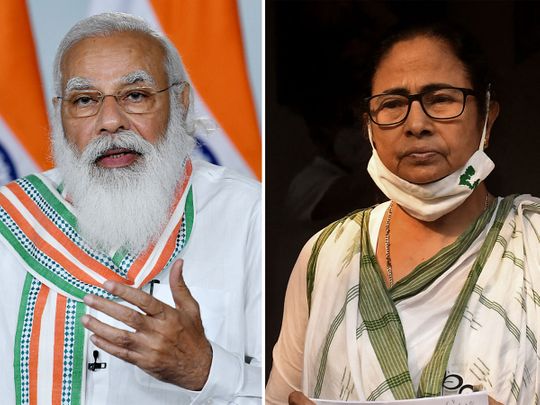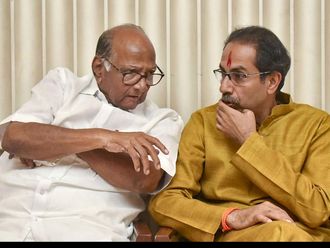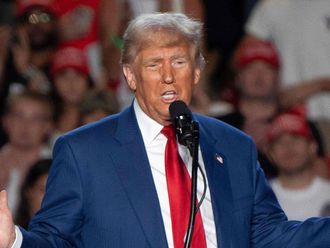
Right through the run-up to these elections in West Bengal and even during all eight phases of polling in the state, the intense turf war between ruling Trinamool Congress (TMC) and principal opposition Bharatiya Janata Party (BJP) had given these elections the look and feel of an ‘eye-for-an-eye’ that was quite unprecedented in Bengal’s political history. That is why, there was a lot at stake.
While for Chief Minister and TMC supremo Mamata it was a huge challenge to stave off the massive BJP election machinery that included heavyweights such as Prime Minister Narendra Modi and federal home minister Amit Shah, for the saffron brigade, the challenge was to further build up on the gains of the 2019 Lok Sabha elections and wrest power in a state that has traditionally rejected right-wing ideology.
A photo finish
And the fight looked poised for a photo finish -- until late Sunday morning!
Ruling TMC is now set to win around 207 seats in Bengal, just four short of its 2016 tally, while BJP will have to be content with about 81. Though from just three seats in 2016 to reaching a tally of 80-plus is no mean achievement, yet, the point is that given the tall claims by the party’s top-brass that BJP would cross the 200-mark in Bengal, the fact that the party will finally end up well below 100 is indeed a huge embarrassment for the Modi-Shah duo and for all those BJP functionaries and leaders from outside Bengal who had camped in the state for the last several months.
So how did Mamata and the TMC manage to buck a perceived anti-incumbency and bring the BJP juggernaut to a grinding halt in a state that many considered as the BJP’s “last frontier”?
BJP beaten at its own game
The answer is: The BJP was beaten at its own game. The attempt to polarise voters in Bengal along communal lines gave rise to a very significant consolidation of the minority Muslim vote in favour of the TMC. This trend was most clearly noticeable in the districts such as Maldaha, Murshidabad, North and South Dinajpur and pockets of South 24 Parganas, where the Muslim voters, who traditionally vote for either the Congress or the Left parties in most elections, have this time voted overwhelmingly for TMC.
This was tactical voting at its best, whereby, the minority community, worried by a threat-perception from the BJP’s brand of communal politics, considered the TMC as the best bet to resist a saffron surge in the state.
On the other hand, in districts such as Hooghly, Howrah, in large swathes of Kolkata, North 24 Parganas, East Midnapore and East and West Barddhaman, even the majority Hindu community has voted overwhelmingly for TMC, negating the BJP’s pitch for a “real change” in Bengal.
This is primarily because even among the majority Hindu voters in the state, the shrill communal content of these elections as propagated by BJP and its leaders forced these voters to take a stand, who would have otherwise held a neutral stance in any TMC-BJP political debate. Traditionally, these are the voters who would have otherwise voted for either the Congress or the Left parties. But this time, this particular category also saw the TMC as a “lesser evil”.
So, effectively, the BJP’s attempt to divide voters along communal lines, triggered two simultaneous trends, neither of which worked in the party’s favour: Firstly, it made the minority Muslims see the BJP as a threat like never before. So they voted tactically for the TMC because they knew a vote for the Congress-Left combine would be a sheer waste since this alliance wouldn’t get anywhere close to forming a government in Bengal. And therefore, by not voting for TMC and allowing a split in the minority vote, they would have left the door open for BJP to sneak in – something they couldn’t have risked by any means.
Failed BJP pitch
Secondly, even among a section of Hindu voters who traditionally support the Congress or Left, the BJP’s election pitch failed to have the desired impact. So this section of voters too voted for TMC, even at the cost of going against their ideological grain because they too thought the BJP’s communal line in Bengal had an antidote only in the form of the TMC.
Identity politics has held its sway in Bengal like never before and for now, it has worked decisively in favour of TMC and Mamata. But there is a cautionary tale in this for Mamata too: That the benefits of identity politics can be short-lived if not backed up by an objective commitment to deliverance and good governance.
She must therefore go back to the drawing board and revisit all those charges of nepotism and corruption levelled against her party and government in the run-up to these polls. But for now, she will soak up this win – undoubtedly the toughest in her career so far.
There is no denying the fact that the ‘war’ that was unleashed on her by the Modi-Shah duo has been won by her, showing the BJP masterminds that no amount of strategising can ever trump people power.
Twitter: @moumiayush








